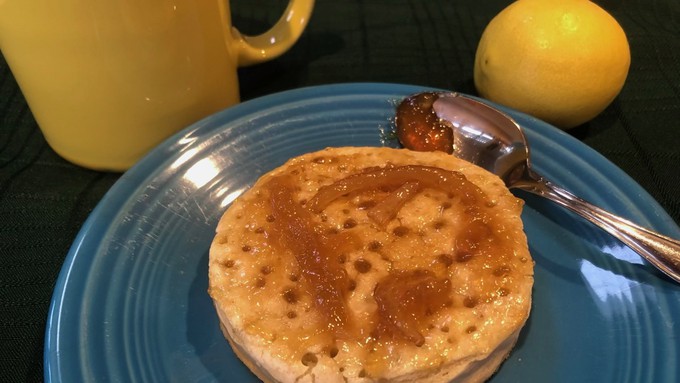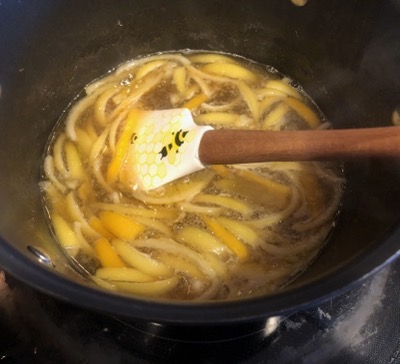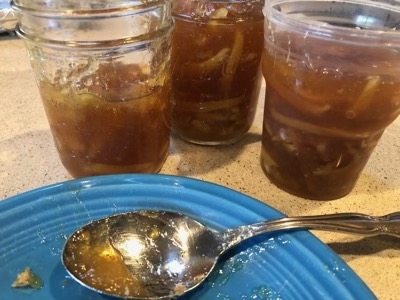
Ripe limes, lemons become breakfast treat -- no canning required

Lime marmalade is a delicious topping for a toasted crumpet or any breakfast bread. (Yes, that's a ripe lime in the background.) Kathy Morrison

When the fruit starts picking itself, it's time to harvest -- and use -- the rest of the crop.
My little lime tree had been shedding the rest of its very ripe fruit this past week, and I had to figure out how to preserve it quickly. I didn't want to juice all the limes -- no telling when I'd get around to using that.
Then I remembered a small-batch marmalade recipe I'd made several years ago. It called for Meyer lemons and blood oranges. Surely it would work for my ripe (yellow) limes.
The beauty of this recipe is that it's strictly refrigerator preserving. No water-bath canning required. I'm an experienced tomato canner, but that's a huge, several-day event in summer. I had nowhere near enough limes for that kind of production.
I've also had little success canning jam in the past. I didn't trust it to gel so I overcooked it, turning it into a sugary glob that could rival gumdrops in texture. I finally decided to leave the jam canning to others: I have a couple good friends (including Debbie) who are excellent jam and jelly makers.
This recipe, adapted from Melissa Clark's in the New York Times, makes about 2-1/2 cups of lovely, just-tart-enough marmalade. To the second batch I added one Meyer lemon, which gave it a slightly more complex flavor. So use what you have.

Citrus contains natural pectin, so water and sugar are the only other ingredients you need. Employ a heavy, non-stick pan and a good spatula, and use the plate test. (More on that below.)
Small-batch refrigerator lime marmalade
Makes 2-1/2 cups
Ingredients:
5 medium limes, or 4 limes and 1 Meyer lemon (or whatever citrus you have)
1-1/4 cups or less granulated sugar (superfine works well if you have it)
1-1/4 cups or less turbinado (raw) sugar
2-1/2 cups or less water
Instructions:
Place a few saucers or small plates in the freezer. Wash the citrus fruit well, and trim off the very ends. Cut each fruit in half, and cut each half into 1/8-inch slices, removing the center membrane.
Measure the fruit: This is crucial. If you have 2-1/2 cups, you're set. If not, add another lime or lemon to make 2-1/2, OR just use what you have, but adjust the amount of water and sugar to match. Example: 2 cups fruit, 2 cups water, 1 cup each of the sugars.

Put the fruit in a heavy-bottom pot and add the water. Bring to a boil over medium-high heat and cook for 20 to 30 minutes, stirring occasionally, until the rinds are soft and fully cooked.
Then stir in the sugar and bring the mixture back to a boil over high heat, then reduce to medium or less (depending on your stovetop) to achieve a consistent simmer.
Let the mixture simmer at least 15 minutes, stirring occasionally, before you start testing it. To test, remove one of those plates from the freezer and drop a half-spoonful or so of the hot liquid onto the plate. Let it sit for a few seconds, then tilt the plate up. If it runs, it's not ready.
Keep cooking and testing the mixture as it starts to thicken, stirring fairly often, and scraping down the sides of the pot. The marmalade could take anywhere from 15 to 35 minutes more to "set," in other words, to become soft and spreadable but not runny. The pot is hot, so the marmalade will be more liquidy there than on the plate -- trust the test. (Another tip: Look at your spatula out of the pot. If it's starting to set there, the marmalade's close to ready.) If you use a candy thermometer to test, the hot mixture should reach 222 degrees.
Remove the pot from the heat and allow the marmalade to cool to almost room

temperature before transferring it to clean jars or freezer-safe containers.
It will keep in the refrigerator about a month and at least 3 months in the freezer.
Comments
0 comments have been posted.Sacramento Digs Gardening to your inbox.
Sites We Like
Garden Checklist for week of May 12
Get your gardening chores and irrigation done early in the day before temperatures rise.
* Plant, plant, plant! It’s prime planting season in the Sacramento area. Time to set out those tomato transplants along with peppers and eggplants. Pinch off any flowers on new transplants to make them concentrate on establishing roots instead of setting premature fruit.
* Direct-seed melons, cucumbers, summer squash, corn, radishes, pumpkins and annual herbs such as basil.
* Harvest cabbage, lettuce, peas and green onions. This heat will cause leafy greens and onions to flower; pick them before they bolt.
* In the flower garden, direct-seed sunflowers, cosmos, salvia, zinnias, marigolds, celosia and asters.
* Plant dahlia tubers. Other perennials to set out include verbena, coreopsis, coneflower and astilbe.
* Transplant petunias, marigolds and perennial flowers such as astilbe, columbine, coneflowers, coreopsis, dahlias, rudbeckia and verbena.
* Keep an eye out for slugs, snails, earwigs and aphids that want to dine on tender new growth.
* Feed summer bloomers with a balanced fertilizer.
* For continued bloom, cut off spent flowers on roses as well as other flowering plants.
* Got fruit trees? If you haven't already done so, thin orchard fruit such as apples, peaches, pears, pluots and plums before they grow too heavy, breaking branches or even splitting the tree. Leave the largest fruit on the branch, culling the smaller ones, and allow for 5 to 6 inches (or a hand's worth) between each fruit.
* Thin grape bunches, again leaving about 6 inches between them. For the remaining bunches, prune off the "tail" end, about the bottom third of the bunch, so that the plant's energy is concentrated in the fruit closest to the branch.
* As spring-flowering shrubs finish blooming, give them a little pruning to shape them, removing old and dead wood. Lightly trim azaleas, fuchsias and marguerites for bushier plants.
* Add mulch to the garden to help keep that precious water from evaporating. Mulch also cuts down on weeds. But don’t let it mound around the stems or trunks of trees or shrubs. Leave about a 6-inch to 1-foot circle to avoid crown rot or other problems.